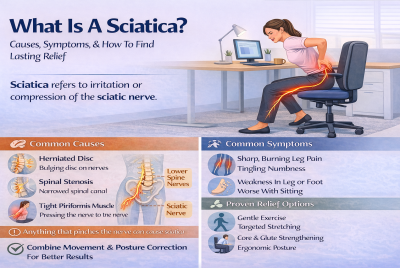Can A Chiropractor Help With Sciatica
Curious about can a chiropractor help with sciatica. Discover how chiropractic care addresses sciatic pain and promotes relief. As an ardent enthusiast in chiropractic care, I have often encountered a burning question – Can a chiropractor help with sciatica? Having pondered and researched extensively, I can confidently affirm, yes, a chiropractor can help with sciatica pain!
Understanding Sciatica
Before diving into chiropractic remedies, let’s first grasp the concept of sciatica pain and What makes sciatica worse.
What Is Sciatica?
Sciatica is a debilitating pain that radiates along the path of the sciatic nerve, which branches from your lower back through your hips and buttocks and down each leg. Usually, sciatica only affects one side of your body.
Causes Of Sciatica
Sciatica occurs when the sciatic nerve is compressed or irritated. This can be due to a herniated disk, and bone spurs on the spine, or narrowing of the spine (spinal stenosis). Sciatica emerges when the sciatic nerve undergoes compression or irritation. This results from various factors, including herniated discs, spinal stenosis, or bone spurs on the spine. These conditions collectively contribute to narrowing the nerve’s pathway, prompting the characteristic pain, numbness, and tingling sensations radiating through the lower back and down the leg, which are hallmarks of sciatica.
The Role Of Chiropractic Care
Chiropractic care plays a vital role in addressing sciatica. But can a chiropractor help with sciatica, and what exactly is it?
What Is Chiropractic?
Chiropractic is a healthcare profession dedicated to the non-surgical treatment of disorders of the nervous system and musculoskeletal system, typically through manual manipulation or adjustment of the spine.
Chiropractic Techniques For Sciatica
What Is The Success Rate Of Chiropractic Treatment For Sciatica?
The success rate of chiropractic treatment for sciatica varies based on individual factors and the severity of the condition. Research suggests that chiropractic care can effectively manage sciatica symptoms in many cases. Some studies indicate a favorable outcome, with a significant reduction in pain and improved functional abilities. However, success rates depend on factors like the underlying cause of sciatica, the patient’s overall health, and adherence to treatment recommendations. Chiropractic techniques such as spinal adjustments, exercise, and manual therapies can contribute to successful outcomes by addressing the root causes and promoting spinal health.
Is It Better To See A Physiotherapist Or Chiropractor For Sciatica?
Deciding between a physiotherapist or a chiropractor for sciatica largely depends on personal preferences and the specific nature of the condition. Physiotherapists emphasize rehabilitation through exercises, stretches, and physical modalities to improve mobility, strength, and posture. They provide a holistic approach, focusing on long-term functionality. Chiropractors primarily use spinal adjustments and manual therapies to address misalignments and nerve compression. Both professions have shown success in managing sciatica. Consulting a physiotherapist may suit those seeking comprehensive rehabilitation, while chiropractors may appeal to those looking for targeted spinal adjustments. It’s crucial to consult with healthcare professionals to determine the most suitable approach based on individual needs and preferences.
How Chiropractors Address Sciatica
Chiropractors adopt several techniques to alleviate the pain and discomfort associated with sciatica. Chiropractors employ various techniques to effectively alleviate the pain and discomfort linked to sciatica, ensuring a comprehensive and tailored approach to each individual’s needs.
Spinal Adjustments
Through spinal adjustments, chiropractors can help realign your spine, releasing the pressure from the sciatic nerve, thereby reducing pain. Utilizing spinal adjustments, chiropractors can realign the vertebrae, relieving undue pressure on the sciatic nerve and consequent pain. Chiropractic interventions restore proper biomechanics by skillfully manipulating the spine’s alignment, promoting optimal nerve function. This approach provides immediate relief and addresses the underlying issues contributing to sciatic discomfort. Through precise adjustments, chiropractors contribute significantly to minimizing pain and fostering the body’s natural healing processes.
Stretching And Exercise
Chiropractors also suggest specific exercises and stretches that can help to minimize sciatic pain. Chiropractors often prescribe targeted exercises and stretches to manage sciatic pain. These tailored routines aim to alleviate pressure on the sciatic nerve and promote flexibility, effectively addressing the root causes of discomfort. By engaging in these exercises regularly, individuals can strengthen supporting muscles, improve posture, and enhance the spine’s overall health, fostering a comprehensive approach to diminishing sciatic pain and preventing its recurrence.
How Can Exercises Help With Sciatica Pain?
Exercise can be an effective way to alleviate and manage sciatica pain. It can help by strengthening the muscles that support the spine, improving flexibility, enhancing blood circulation to the affected area, and promoting the release of endorphins, which are the body’s natural painkillers.
Let’s break down these benefits further:
- Strengthening Muscles: Exercises that target the back and abdominal muscles can provide better support for the spine, reducing the pressure on the sciatic nerve.
- Improving Flexibility: Stretching exercises can help loosen the tight muscles in the lower back, hips, and legs that often contribute to sciatica pain. Improved flexibility can result in a wider range of motion and reduced nerve impingement.
- Enhancing Circulation: Regular exercise promotes better blood circulation, ensuring an adequate supply of nutrients to the lower back and nerve tissues, promoting healing and reducing pain.
- Endorphin Release: Physical activities stimulate the production of endorphins. These chemicals work as natural painkillers and mood elevators, reducing pain perception.
Some specific exercises that can help with sciatica pain include:
- Knee to Chest Stretches: These stretches can help loosen the lower back and hip muscles.
- Sciatic-Mobilizing Stretch: This helps to stretch out the lower back and gluteal muscles, reducing the pressure on the sciatic nerve.
- Back Extensions: This exercise can help to relieve the compressed sciatic nerve by creating space in your spinal canal.
- Pigeon Pose: This yoga pose opens the hips and helps relieve sciatic pain.
Remember, talking to a healthcare provider before starting any new exercise regimen is crucial, especially if you’re dealing with a condition like sciatica. They can guide what exercises are safe and most beneficial for your situation.
Massage Therapy
It can increase blood flow and reduce muscle stiffness, often contributing to sciatic pain. Massage for sciatica is a proven approach for enhancing circulation and alleviating muscle rigidity, which is pivotal in mitigating sciatic pain. By employing specialized techniques, massage stimulates blood flow, fostering the delivery of oxygen and nutrients to affected areas. This heightened circulation aids in reducing muscle tension, subsequently alleviating the pressure on the sciatic nerve. Moreover, the tactile manipulation of tissues prompts the release of endorphins, natural pain-relievers that further enhance comfort. As a comprehensive remedy, massage therapy is a valuable resource in combating the discomfort associated with sciatica.
Benefits Of Chiropractic Care For Sciatica

Chiropractic care has a plethora of benefits when it comes to sciatica.
Non-Invasive Treatment
One of the top advantages is that it’s a non-invasive method. There’s no surgery or drugs, just a hands-on approach.
Reduces Inflammation
Chiropractic adjustments can help reduce inflammation, one of the key causes of sciatic pain.
Pain Management
Chiropractic care often results in instant pain relief, and with consistent treatment, chronic sciatica pain can be managed effectively.
Enhances Mobility
Chiropractic treatment can also help improve the range of motion, enabling you to get back to your regular activities faster.
Chiropractic treatment can significantly improve the range of motion in both the spine and extremities. This is largely because it focuses on correcting structural alignment and improving the body’s physical function. Here’s how:
- Spinal Adjustments: A chiropractor uses their hands or a small instrument to apply a controlled, sudden force to a spinal joint. The aim is to improve spinal motion and your body’s physical function. Regular adjustments can help restore alignment, relieve pain, and increase flexibility and mobility.
- Joint Mobilization: Chiropractors often use joint mobilization techniques, which involve moving and stretching the joints in a way that the patient cannot do on their own. This can help to increase flexibility and range of motion.
- Physical Therapy: Many chiropractors will also incorporate physical therapy exercises into their treatment plans. These exercises are designed to strengthen and stretch the muscles that support the joints, further helping to improve mobility.
- Massage: Massage can help relieve muscle tension and stiffness, which can restrict movement. By relieving this tension, chiropractic care can help to improve flexibility and range of motion.
- Improved Posture: Regular chiropractic care can also lead to improved posture. A proper posture can reduce unnecessary strain on your muscles and joints, allowing for better movement and flexibility.
Can Chiropractor Make Sciatica Worse
While chiropractic care can relieve many individuals with sciatica, it could sometimes exacerbate symptoms. If the underlying cause of sciatica isn’t accurately identified or the chiropractic techniques applied are too forceful or inappropriate for the specific condition, it could worsen symptoms. This is why it’s crucial to consult a qualified and experienced chiropractor who conducts a thorough assessment, communicates effectively, and adjusts treatments based on individual needs. It’s also recommended to discuss any concerns with the chiropractor and maintain open communication throughout the treatment process to minimize the risk of worsening symptoms.
Factors To Consider Before Starting Chiropractic Care
Before jumping onto the chiropractic bandwagon, it’s crucial to consider a few factors.
Medical History
Your medical history, including any past injuries or existing health conditions, can affect the effectiveness of chiropractic treatment.
Severity And Location Of Pain
The severity and location of your sciatica pain may also influence the type and intensity of chiropractic treatment you need.
Personal Comfort With The Chiropractor
Lastly, how comfortable you are with your chiropractor is essential. A good relationship will enhance your treatment experience.
How Long Does It Take For A Chiropractor To Fix Sciatica?
The duration for a chiropractor to alleviate sciatica varies based on factors such as the underlying cause, the severity of the condition, the patient’s overall health, and their response to treatment. Some individuals might experience relief after a few sessions, while others may require several weeks or months of consistent chiropractic care. Improvement typically involves a gradual reduction in pain and discomfort, improved mobility, and overall spinal health. Chiropractic treatment aims to address the root causes of sciatica and promote healing. Still, having realistic expectations and maintaining open communication with the chiropractor to track progress and adjust the treatment plan as needed is essential.
Should I Go To A Chiropractor For Sciatica Pain?
Consulting a chiropractor for sciatica pain can be a viable option. Chiropractors specialize in spinal health and can provide targeted treatments like spinal adjustments and manual therapies that may alleviate sciatica symptoms. However, the decision should be made after considering personal preferences, the severity of the condition, and consulting with a healthcare professional. Choosing a reputable chiropractor, communicating openly about your symptoms, and discussing treatment expectations are essential. Collaborating with medical experts can help determine if chiropractic care aligns with your overall healthcare approach for managing sciatica pain.
Sciatica Adjustment At Home
Attempting sciatica adjustments at home without professional guidance is risky and not recommended. Spinal adjustments require precise knowledge and skill to avoid potential harm. Incorrect adjustments might worsen the condition, cause injury, or lead to other health complications. If experiencing sciatica, it’s safer to consult a qualified healthcare provider, such as a chiropractor or physiotherapist, who can assess the situation, provide tailored treatments, and guide exercises or stretches that are suitable for your specific condition. Home remedies like gentle stretches and heat application can be helpful, but any self-adjustment attempts should be avoided due to the potential dangers.
Frequently Asked Questions (FAQs)
1. Is chiropractic care safe for sciatica?
Yes, chiropractic care is generally safe and non-invasive. It focuses on the body’s ability to heal itself without surgery or medication.
2. How many chiropractic sessions are needed for sciatica relief?
The number of sessions varies depending on the severity of your sciatica. Your chiropractor will develop a personalized treatment plan for you.
3. What should I do after a chiropractic session for sciatica?
After a chiropractic session, it’s best to rest, stay hydrated, and perform any recommended exercises or stretches.
4. Can sciatica return after chiropractic treatment?
While chiropractic care can effectively treat sciatica, it’s not a guaranteed cure. Maintaining a healthy lifestyle and regular exercise can help prevent recurrence.
5. Is chiropractic care for sciatica covered by insurance?
Coverage for chiropractic care varies by insurance provider and plan. It’s best to check with your insurance company for specifics.
6. Can a chiropractor help with sciatica?
Yes, a chiropractor can help with sciatica. Chiropractic adjustments realign the spine, reducing pressure on the sciatic nerve, which alleviates pain. They can also improve spinal mobility, reduce inflammation, and enhance the body’s self-healing capabilities. Regular treatments can help manage sciatica symptoms and prevent future episodes, complementing an overall management strategy.
Can A Chiropractor Help With Sciatica – Conclusion
In conclusion, while sciatica can be extremely debilitating, chiropractic care can offer effective relief. It’s a non-invasive treatment method that can manage pain, reduce inflammation, and enhance mobility. However, it’s critical to consider personal factors such as medical history and comfort with the chiropractor before beginning treatment.
Disclaimer
Please note that this article should not replace professional medical advice. Consult a healthcare professional for an accurate diagnosis and tailored treatment plan.
👉 Explore more:





